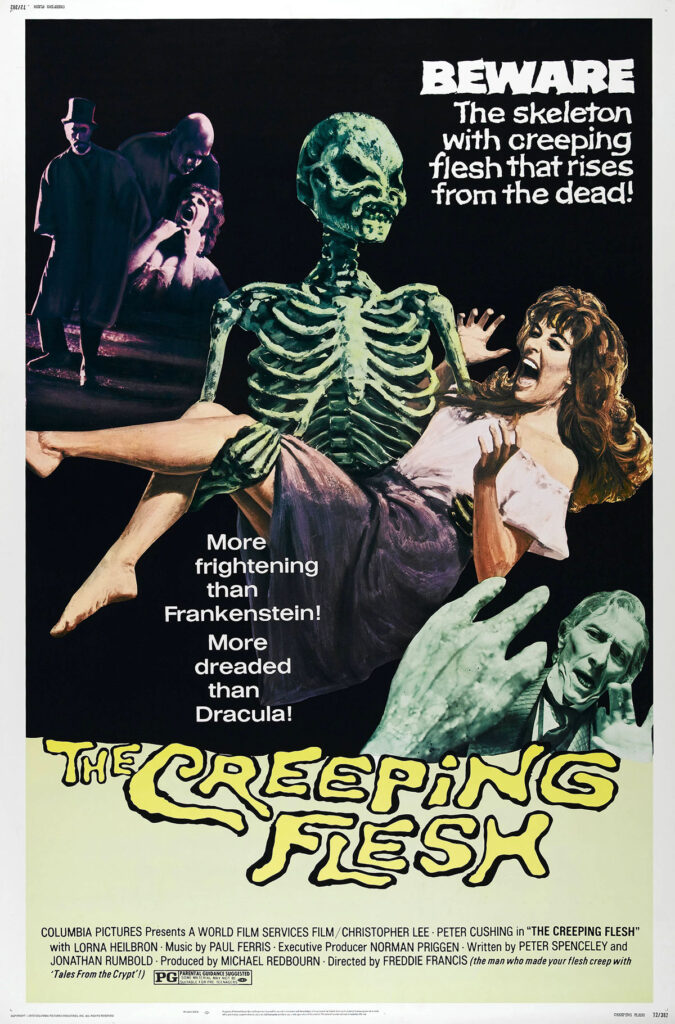When is a Hammer flick not a Hammer flick? Well, when it wasn’t made by Hammer. It’s not a trick question. But, the filmmakers behind The Creeping Flesh, from 1973, made every effort to craft a movie indistinguishable from a Hammer flick, going so far as to cast Hammer Film Productions’ two biggest icons in Peter Cushing and Christopher Lee.
Taking place in Victorian England, Cushing plays Emmanuel Hildern, a scientist recently returned from an expedition abroad. He has returned with a monstrous skeleton he excavated, which he hopes proves his theories about the origin of man.
Emmanuel is an obsessive, ignorant of just about all that goes on around him while he is pursuing his research. He had left his adult daughter, Penelope (Lorna Heilbron), in charge of the house while he was away, and his finances slowly dwindled. Part of his obsessiveness may stem from familial tragedy. His wife (Jenny Runacre, in flashback), a tavern dancer and harlot, went mad when Penelope was a young child and was committed to an asylum run by Emmanuel’s brother, James (Lee). For a host of uptight English gentlemanly reasons, Emmanuel told Penelope that her mother had died, when, in fact, she had survived all these years, right up until the time Emmanuel returned home. To make matters worse, James had been studying Emmanuel’s wife, and was preparing to publish his research, in the hopes of winning a science prize for which Emmanuel was also angling.
That’s a lot of plot, and there’s still more.
Late one evening, while cleaning a portion of the skeleton, Emmanuel discovers that water causes the bones to reconstitute their flesh. It’s just a finger at this point in the movie (a hilarious, phallic thing). Emmanuel then discovers that the blood of this flesh has properties not unlike disease, and he concludes this flesh is a physical  manifestation of evil, based on the myths of the area where the skeleton was discovered. He creates what he believes is a vaccine that inoculates against evil from this creature’s blood, and gives it to Penelope while she sleeps, after he begins to fear for her sanity.
manifestation of evil, based on the myths of the area where the skeleton was discovered. He creates what he believes is a vaccine that inoculates against evil from this creature’s blood, and gives it to Penelope while she sleeps, after he begins to fear for her sanity.
Of course, the vaccine doesn’t work as intended. Rather than cure Penelope of impending insanity, it turns her into a Mr. Hyde analogue — unrestrained in emotion or behavior. It gets so bad that Penelope ends up at the asylum just like her mother, and James confronts Emmanuel over his experiments. James steals the skeleton so he can take credit for Emmanuel’s research, successful or not, and the skeleton is exposed to torrential rainfall, soaking it and restoring its flesh. Finally, we get to the promise of the title.
This is a movie packed full of story, and then in the final act it descends into full scale b-movie silliness. The creature is little more than a mask, as James thoughtfully draped the skeleton in a cloak while stealing it, giving the special effects folks a break.
Emmanuel is a flawed protagonist, to the point he could be considered one of the film’s bad guys. His grieves constantly for his wife, even while she was still alive and imprisoned, to the point he smothered his daughter. Locked away in the house for years as she was, it’s no surprise when, finding a little freedom, she goes off the rails. Emmanuel was so oppressive that it wasn’t necessary to introduce the flawed vaccine as a plot device. But, it was just another thing for which Emmanueal could blame himself, and he seemed to be into that kind of guilt.
Cushing’s portrayal of Emmanuel was excellent. He brought viewers along on a rollercoaster of emotion. Never the cold, considered scientist of cliché, Emmanuel is almost manic in everything he does. Those emotions, in fact, are what lead the character to make all the poor decisions that drive the plot. Cushing played Emmanuel as a man barely holding on, at times willing to throw away all the order he craves in life, then pulling back at the last second before he loses too much control. He’s a chaos addict who thinks he desires peace and quiet.
As for Lee, despite top billing, and a setup that points to much conflict between the brothers, he has no significant presence in the film until the final act. He’s useful in wrapping up the story, and gave a fine performance, as well, but James was somewhat superfluous, all the way until he suddenly was not. It was a tricky balancing act on the part of director Freddie Francis and company.
Heilbron was also quite good as Penelope. Hers is the most desperate character of the film. All three principals are deprived of what could be called normalcy, but with Emmanuel and James, that’s by choice. Penelope is victimized by the morals of the times, and her treatment by her relatives. The stress this causes the character is portrayed to effect by Heilbron, making her character more than just the stock female relative or damsel in distress.
At times, The Creeping Flesh is a very engaging Gothic horror story. At others it’s a fun house flick about a mad scientist, or two. It ends up having more plot than it could resolve, but Francis and screenwriters Peter Spenceley and Jonathan Rumbold made sure that by the time the credits rolled, those loose threads no longer mattered. The Creeping Flesh would be a welcome addition to anyone’s October horror viewing.
